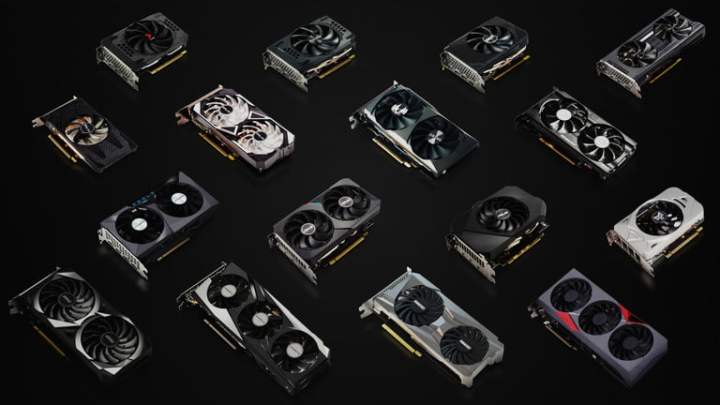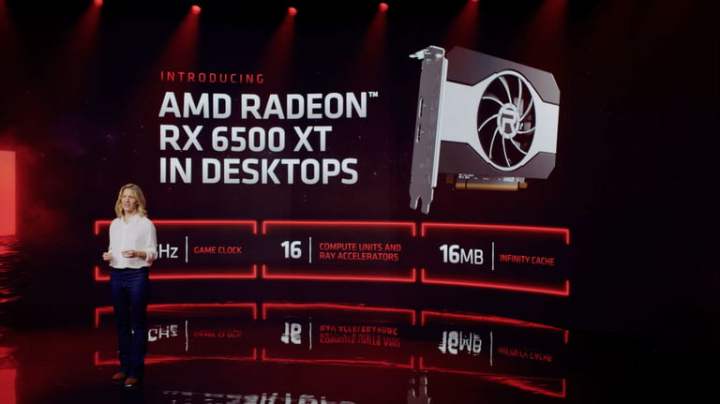The Nvidia RTX 3050 and AMD RX 6500 XT are two of the potentially most affordable entry-level graphics cards of their respective generations. If availability isn’t a problem (and it may well be), they should offer the most accessible pricing of any current-generation graphics cards for quite some time. But how do they measure up?
Which offers the best bang for buck? The Nvidia RTX 3050 or the AMD RX 6500 XT?
Specs
| Nvidia RTX 3050 | AMD RX 6500 XT | |
| GPU | GA106 (rumored) | Navi 24 |
| Process | 8nm | 6nm |
| Interface | PCIE x16 | PCIE x4 |
| Shader processors | 2,560 CUDA Cores | 1,024 Shading Units |
| Ray tracing accelerators | 20 RT cores (rumored) | 16 ray accelerators |
| Tensor cores | 80 (rumored) | NA |
| Base block | 1.55 GHz | Unknown |
| Game clock | NA | 2,610 MHz |
| Boost clock | 1.78 GHz | 2,815 MHz |
| Memory | 8GB GDDR6 | 4GB GDDR6 + 16MB Infinity Cache |
| Memory speed | 14 Gbps (rumored) | 18 Gbps |
| Memory bus width | 128-bit | 64-bit |
| Bandwidth | Unknown | 144GBps (Effective 305 GBps with Infinity Cache) |
| TDP | 130W | 107W |
Pricing and availability
Neither of these graphics cards are available just yet, but they’re coming down the pipe in short order. The Nvidia RTX 3050 is slated to release on January 27 with a recommended retail price of $249. The AMD RX 6500 XT is coming a little sooner, with a release date of January 19.
Its recommended price of just $199 makes it the notably cheaper GPU, although that may not be the case in all territories. The European retail price for the 6500 XT has already been inflated to the equivalent of $340, so we’ll need to see what these cards actually retail for when they release.
Performance

We don’t have any third-party testing for these cards just yet, so there is no definitive way to know how performative either of these cards are. What we can do, though, is look at the specifications, and at the first-party comparative results released by both AMD and Nvidia at CES 2022, and make a relative estimate of how a head-to-head battle between these two cards would shake out.
Both the RTX 3050 and RX 6500 XT are designed to be 1080p graphics cards, replacing older 1080p standouts like the GTX 1650 and the RX 570/580. Nvidia’s testing showed the RTX 3050 as being more than capable of delivering 60-plus frames per second (fps) in a number of major games, including F1 2021, Control, and Doom Eternal. But in each case, that was with deep learning super sampling (DLSS) enabled, which doesn’t give us a clear idea of performance, because older cards like the GTX 1650 can’t use that upscaling technology and not every game supports it.
In AMD’s benchmarks, it showed the RX 6500 XT as being a somewhat arbitrary 23% to 59% faster than the GTX 1650 in games like Age of Empires 4, Apex Legends, and Resident Evil: Village. That’s good, but without actual frame rates, it doesn’t tell us much.
Looking at the specifications, the RTX 3050 should have a major advantage when it comes to enabling advanced visual settings, thanks to having double the GDDR6 memory. We don’t know its bandwidth yet, but it should be higher than that of the RX 6500 XT, though the Infinity Cache there may help AMD close the gap as it has done with some of its higher-end RDNA 2 graphics cards.
The 6500 XT also has a massive clock speed advantage over the RTX 3050, which could also offer competitive performance with the Nvidia GPU.
Considering where the companies have priced these cards, it wouldn’t be a surprise to see the RTX 3050 be the slightly more powerful card, with AMD nipping at its heels and even surpassing it in some games. We’ll need to see some unbiased real-world testing to know for sure.
Upscaling and ray tracing

Both graphics cards support an optional upscaling technology to improve performance in supporting games. The RTX 3050 has Nvidia’s Tensor Cores to let you use DLSS for impressive performance gains in select games, which can make quite a difference — especially when you’re gaming on an entry-level card like this.
The RX 6500 XT doesn’t have any dedicated hardware to upscale in-game visuals, but it can use AMD’s Fidelity FX Super Resolution in select games — a technology we’ve been quite impressed with. The RTX 3050 can use it too, however, with some games even offering the option of both FSR and DLSS to choose from.
Both cards also support ray tracing, although you’re unlikely to use it in any grand capacity as, even with dedicated hardware acceleration, it’s going to mean a big performance hit, especially the with weaker accelerators in the 6500 XT. Still, having the option is nice, and as games get better at implementing it, being able to turn it on for gameplay improvements, even at the cost of frame rate, is nice to have.
Interfaces and media encoding
One area of concern with the 6500 XT at this untested, prerelease stage of its life cycle is the limited PCIE x4 interface. While this shouldn’t matter in newer motherboards with PCIE 4 support, in older PCIE 3 boards it could represent a constraint on bandwidth that could limit overall performance. Considering gamers with older PCs are the likely target audience for a card like this, it seems like a puzzling design choice from AMD.
In comparison, the RTX 3050 can take full advantage of PCIE x16 interfaces. It won’t use anything close to the maximum bandwidth, but there won’t be a bottleneck at the slot, even on older motherboards.
AMD also made the surprising choice to disable H264/HEVC encoding and AV1 decoding on the 6500 XT. That could cause some problems with streaming at higher resolutions, and will limit the ability for it to work with Oculus Quest headsets. Those aren’t huge deal breakers for a card targeting 1080p gaming, but it’s a shame to see such standard features stripped from the card.
The 6500 XT isn’t great, but it might be all you can get
Out of these two cards, the RTX 3050 looks likely to be the more powerful when it launches. Everything from its more expansive memory configuration to its ability to use DLSS and its higher price tag suggests it should be the more powerful GPU. However, its 8GB of RAM might be its downfall because that lets cryptocurrency miners use it to mine Etherum. The limited 4GB of GDDR6 on the 6500 XT makes it nonviable for that, which may make it far easier to obtain.
We still don’t know if either of these cards will be produced in enough volume to thwart scalpers, but AMD has made bold claims about providing strong volume for this entry-level GPU. If the $200 price is relatively accurate, it’s likely to be a very popular card among gamers. If they can get their hands on it, it could be a decent buy at a time where getting hold of any card at a reasonable price isn’t easy.
The RTX 3050 should be the better card, but it might lose out due to its own higher specs.





